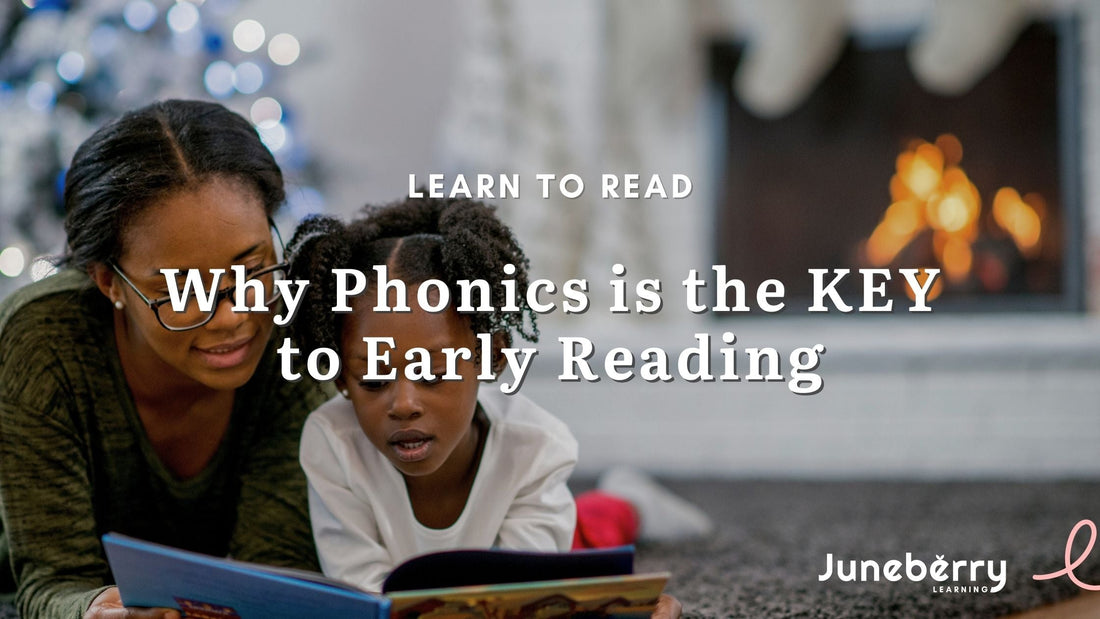
Why Phonics is the KEY to Early Reading
Share
The English alphabet is an invented code that is used to record spoken language. Babies learn to speak by being immersed in language and interacting with others. Learning to read and write does not happen naturally. These skills have to be learned.
Phonics is the key to unlocking the alphabetic code to map the 20,000 to 50,000 plus words that adults can instantly recognize by sight. You can’t possibly memorize that many words.
1. The Alphabet is an Invented Code
The English alphabet is made up of 26 letters which can be combined in sound patterns to form words. These sounds are called phonemes. They can be represented by just one letter (b in bat, p in pig) or up to 4 letters (ough in dough, or ueue in queue).
Letters have 26 names, ~44 sounds, and 52 shapes (lower and upper case). Eventually your child will need to know all of them. It seems like a daunting task, but if you think about how easily they remember the complex names of dinosaurs and sea creatures, and the hundreds of other words they’ve learned, it’s easy to see that a joyful learning space and lots of practice makes it possible.
2. Speaking comes naturally but reading does not
Babies learn spoken language even before they are born. Speaking comes naturally to them from being around others who use the language to communicate with them. Babies begin speaking with coos and babbles and soon their oral language becomes more practiced and purposeful. Eventually, they can communicate clearly with anyone who speaks their language.
Written language is based on an invented code, so it isn’t learned naturally. The code has to be studied and practiced. Your child needs to learn the connections between letters and the sounds they represent. This is called phoneme-grapheme correspondence. There are approximately 44 of these sound-letter connections, which have to be learned to become a strong reader.
It takes 3-4 years for a child to learn the code well enough to read fluently. Fluent reading is possible when words are recognized effortlessly. This makes it easier to focus on the meaning of what is being read, which is the goal of reading.
Speaking comes naturally, but reading does not because it is based on an invented code. The code has to be learned to become a fluent reader.
3. You can’t memorize 20,000 to 50,000+ words
There are hundreds of thousands of words in the English Language, and new words and variations are constantly being added. It’s not practical to memorize individual words. That’s why children need to be taught the alphabetic code and the structures that the language is built on.
We do not learn words by their size and shape. If we did, we would not be able to recognize them when they are written in different fonts or at different angles, such as vertically or slanted.
We read words because we have mapped them into our long term memory based on their pronunciation, spelling, and meaning. Once a word is solidly stored in memory, it becomes a sight word and can be instantly recalled, when we see it.
Memorizing so-called sight words, just by seeing them on a flash card, is not effective. Words have to be learned in their usable form, in sentences, as many words do not carry meaning on their own. Try drawing a picture of the, was, a, and, said. These words only have meaning when surrounded by other words.
There are so many words in an adult’s spoken vocabulary that it would be impossible to learn to read all of them without knowing the alphabet code. The invented code connects letters to the sounds they represent. You have to learn the code to read words that are written in the code.
Summary
Spoken language is recorded in written form using an invented code. Babies easily learn spoken words by listening to others speak, but they do not learn to read and write by watching other people read and write. These skills do not come naturally and have to be learned.
Learning letter-sound correspondences, blending sounds together to read words, and tearing words apart into sounds are the keys to using the alphabetic code. Adults can instantly recall from 20,000 to 50,000+ words. It would be impossible to memorize all those words. The key to reading and writing is learning to use the sounds of reading.
At Juneberry Learning, we encourage you to use just 5 minutes a day of bite size learning and playful activities to help your child learn the sounds of reading. Our Alphabites Game Pack has 39 sound cards, 26 games, 400+ child friendly words, and 32 hilarious tongue twisters. We designed it especially for parents like you who want to make teaching your child to read an easy and joyful experience.
Please reach out to us at hello@juneberrylearning.com with your questions or comments. You know your child best so choose what works for them. We are here to cheer you on through playful learning for growing young minds.
